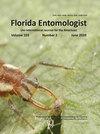巴西亚热带潮湿地区的玉米蚜(半翅目:蚜科):分布、季节性和生物学
IF 1.2
4区 农林科学
Q3 ENTOMOLOGY
引用次数: 1
摘要
五月花蚜(Passerini)(半翅目:蚜科)是一种引入美国的栽培谷物和野草害虫,于2002年在南美洲阿根廷首次报道。在巴西,这种蚜虫于2006年10月在南里奥格兰德州的小麦中首次被发现。2007年至2013年间,据报道,在巴西潮湿的亚热带地区的几个地方(南里奥格兰德州、圣卡塔琳娜州和巴拉那州),不同植物物种上都出现了这种蚜虫,包括小麦、燕麦。,多花Lolium multiflorum Lam。,大麦(Hordeum vulgare L.)、玉米(Zea mays L.)(均为禾本科植物)和未培养的草。Sipha maydis也被黄色托盘陷阱捕获。maydis的飞行活动高峰出现在春夏过渡期,与平均气温明显相关。五月花能够在A.strigosa、L.multiflorum、H.vulgare、Z.mays和T.aestivum上完成其生命周期。若虫期最佳寄主为糙伏草、何首乌、芒草和夏枯草。大麦和夏枯草的生育期和寿命最好。内生增长率以糙伏草、何首乌和夏枯草最高。H.vulgare、Z.mays和T.aestivum的世代时间较长。H.vulgare和T.aestivum的净繁殖率更高,而A.strigosa、L.multiflorum、H.vulgale和T.ae斯蒂vum的有限繁殖率最大。尽管玉米蚜的分布正在扩大,并覆盖了巴西的主要小麦种植区,尽管寄主范围广泛,对当地觅食地造成了直接破坏,但蚜虫的数量很少,其经济重要性有限。然而,它揭示了S.maydis具有在亚热带地区殖民的潜力。五月花(Passerini)是一种由美国引进的栽培谷物和野草害虫,于2002年在南美洲阿根廷首次报道。2006年10月,在巴西南里奥格兰德州首次在小麦中发现黑粒蚜。2007年至2013年间,据报道,在巴西潮湿的亚热带地区的几个地方(南部地区州:南里奥格兰德州、圣卡塔琳娜州和巴拉那州),不同的植物物种中都有这种蚜虫,如T.aestivum、Avena strigosa Schreb。,多花Lolium multiflorum Lam。,大麦(Hordeum vulgare L.)、玉米(Zea mays L.)(均为禾本科植物)和未开垦的草。玉米夜蛾也被带翅蚜虫的黄色托盘诱捕器捕获。有翅型在春夏过渡期的出现高峰与平均气温有明显的相关性。五月花能够完成A.strigosa、L.multiflorum、H.vulgare、Z.mays和T.aestivum的生命周期。在若虫期,寄主最好的是糙伏草(A.strigosa)、何首乌(L.multiflorum)、芒草(H.vulgare)和夏枯草(T.aestivum)。H.vulgare和T.aestivum的生育期和寿命最好。粗毛A.strigosa、多花L.multiflorum和普通T.aestivum的内在增长率较高;一代时间在H.vulgare、Z.mays和T.aestivum中较长;粗花和普通T.aestivum的净繁殖率最优,而粗花、多花L.vulture、普通T.ae斯蒂vum的有限繁殖率较高。尽管玉米蚜的分布正在扩大,并覆盖了巴西的主要小麦区,尽管寄主范围广泛,对觅食地造成了直接破坏,但蚜的数量很低,其经济重要性仍然有限。然而,它揭示了S.maydis有可能在亚热带地区殖民。本文章由计算机程序翻译,如有差异,请以英文原文为准。
Sipha maydis (Hemiptera: Aphididae) in the Humid Subtropical Region of Brazil: Distribution, Seasonality and Biology
Abstract Sipha maydis (Passerini) (Hemiptera: Aphididae) is a pest of cultivated cereals and wild grasses introduced into America and first reported in South America at Argentina in 2002. In Brazil, this aphid was detected first in wheat in Oct 2006 at Rio Grande do Sul State. Between 2007 and 2013 the aphid was reported in several localities in the humid subtropical region of Brazil (southern states of Rio Grande do Sul, Santa Catarina, and Paraná) on different plant species including Triticum aestivum L., Avena strigosa Schreb., Lolium multiflorum Lam., Hordeum vulgare L., Zea mays L. (all Poaceae) and uncultivated grasses. Sipha maydis also has been captured in yellow tray traps. Peak flight activity for S. maydis occurred in the spring-summer transition and was apparently correlated with average air temperature. Sipha maydis was able to complete its life cycle on A. strigosa, L. multiflorum, H. vulgare, Z. mays, and T. aestivum. During the nymphal phase the best hosts were A. strigosa, L. multiflorum, H. vulgare, and T. aestivum. Hordeum vulgare and T. aestivum were the best for the reproductive period and longevity. The intrinsic rate of increase was greatest on A. strigosa, L. multiflorum, and T. aestivum. Generation time was longer on H. vulgare, Z. mays, and T. aestivum. Net rate reproduction was greater in H. vulgare and T. aestivum, and the finite rate of increase was greatest on A. strigosa, L. multiflorum, H. vulgare, and T. aestivum. Although the distribution of S. maydis is expanding and covering the main wheat-growing region of Brazil, and despite the wide range of hosts and the direct damage it causes to local foraging sites, aphid populations are low and their economic importance is limited. However, it reveals that S. maydis has the potential to colonize subtropical regions. Resumen Sipha maydis (Passerini) é uma praga de cereais cultivados e gramíneas silvestres introduzida na América e relatada pela primeira vez na América do Sul na Argentina em 2002. No Brasil, o pulgão-preto-dos-cereais foi detectado pela primeira vez em Triticum aestivum L. em outubro de 2006 no Estado do Rio Grande do Sul. Entre 2007 e 2013, o pulgão foi relatado em várias localidades da região subtropical húmida do Brasil (Estados da Região Sul: Rio Grande do Sul, Santa Catarina e Paraná) em diferentes espécies de plantas como T. aestivum, Avena strigosa Schreb., Lolium multiflorum Lam., Hordeum vulgare L., Zea mays L. (todas Poaceae), e gramíneas não cultivadas. Sipha maydis também foi capturado em armadilhas do tipo bandeja amarela para pulgões alados. O pico de ocorrência das formas aladas na transição primavera-verão é aparentemente correlacionado com a temperatura média do ar. S. maydis foi capaz de completar o ciclo de vida em A. strigosa, L. multiflorum, H. vulgare, Z. mays, e T. aestivum. Durante a fase de ninfa, os melhores hospedeiros foram A. strigosa, L. multiflorum, H. vulgare, e T. aestivum. A H. vulgare e o T. aestivum foram os melhores para o período reprodutivo e longevidade. A taxa intrínseca de aumento foi grande em A. strigosa, L. multiflorum, e T. aestivum; o tempo de uma geração foi mais longo em H. vulgare, Z. mays, e T. aestivum; a taxa líquida de reprodução foi ótima em H. vulgare e em T. aestivum e a taxa de aumento finito foi grande em A. strigosa, L. multiflorum, H. vulgare, e T. aestivum. Embora a distribuição de S. maydis esteja se expandindo e cobrindo a principal região tritícola do Brasil, e a despeito da ampla gama de hospedeiros e dos danos diretos que causa aos sítios de alimentação, as populações de pulgões são baixas e sua importância econômica ainda é limitada. No entanto, revela que S. maydis tem potencial para colonizar regiões subtropicais.
求助全文
通过发布文献求助,成功后即可免费获取论文全文。
去求助
来源期刊

Florida Entomologist
生物-昆虫学
CiteScore
2.10
自引率
7.10%
发文量
44
审稿时长
3 months
期刊介绍:
Florida Entomologist is the official journal of the Florida Entomological Society. Volumes 1-3 were published under the name The Florida Buggist. The Florida Entomological Society still produces the traditionally printed version of Florida Entomologist, but you can also view, search, or print any article published since June 1917 by accessing online files. Web access is made possible by the Society’s electronic publication project begun in 1993
 求助内容:
求助内容: 应助结果提醒方式:
应助结果提醒方式:


